The Runcitruncated 16-cell
The runcitruncated 16-cell is a uniform polytope in the tesseract family. Its surface consists of 80 cells (8 rhombicuboctahedra, 16 truncated tetrahedra, 24 cubes, 32 hexagonal prisms), 368 polygons (64 triangles, 240 squares, 64 hexagons), 480 edges, and 192 vertices.
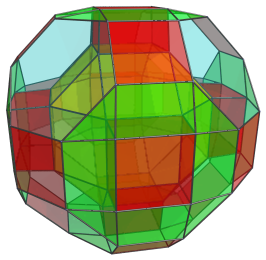
The runcitruncated 16-cell may be constructed by radially expanding the rhombicuboctahedral cells of the cantellated tesseract outwards, and filling the gaps with truncated tetrahedra, cubes, and hexagonal prisms. It may also be constructed by radially expanding the truncated tetrahedral cells of the truncated 16-cell outwards, and filling in the gaps with suitable polyhedra.
Structure
The Near Side
We shall explore the structure of the runcitruncated 16-cell using its parallel projection into 3D, centered on one of its rhombicuboctahedral cells:
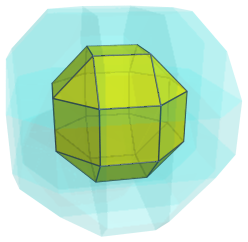
The above image shows the nearest cell to the 4D viewpoint: a rhombicuboctahedron. For clarity, we render all the other cells in a light transparent color, and only show the edges on this nearest cell.
The six axial square faces of this rhombicuboctahedron are joined to 6 cubes, shown next:
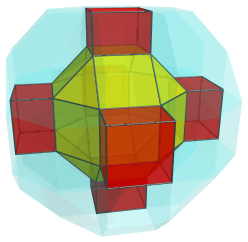
The other 12 square faces of the nearest cell are joined to 12 hexagonal prisms:
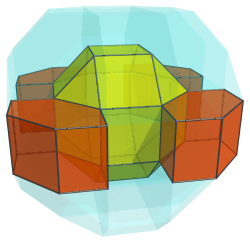
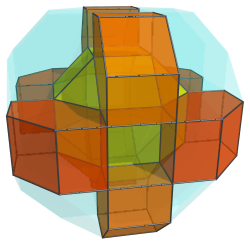
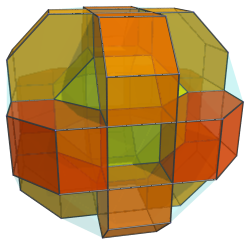
The triangular faces of the nearest cell are joined to 8 truncated tetrahedra:
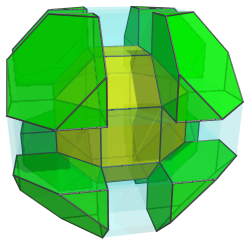
Here are all these cells together:
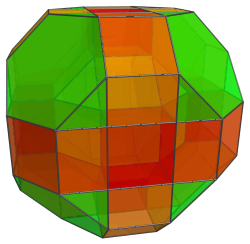
These are all the cells on the near side of the runcitruncated 16-cell.
The Equator
Following this are the cells on the “equator” of the runcitruncated 16-cell. There are 6 rhombicuboctahedral cells on the equator, as shown below:
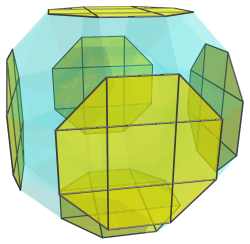
For clarity, we've omitted the cells that we have seen so far. These rhombicuboctahedra have been foreshortened into octagons, because they are being seen from a 90° angle. In 4D, they are perfectly uniform rhombicuboctahedra.
These rhombicuboctahedra are connected to each other via 12 cubes:
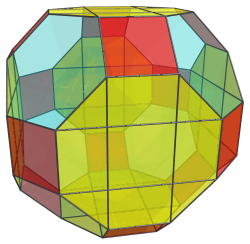
These cubes have been foreshortened into squares, because they are being seen from a 90° angle. In 4D, they are perfectly regular cubes.
The remaining hexagonal gaps are where 8 hexagonal prisms fit in:
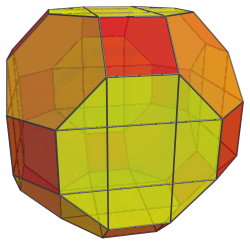
These hexagonal prisms join the 8 truncated tetrahedra from the near side of the runcitruncated 16-cell to their counterparts on the far side. They have been foreshortened into hexagons because they are being seen from a 90° angle; as with the other cells on the equator, they are perfectly uniform hexagonal prisms in 4D.
These are all the cells on the equator. Past this point, the cells on the far side are arranged in the same way as the cells on the near side, except in reverse order, until we reach the farthest cell, the antipodal rhombicuboctahedron from the nearest cell.
Summary
The following table summarizes the cell counts of the runcitruncated 16-cell:
| Region | ||||
|---|---|---|---|---|
| Near side | 1 | 6 | 12 | 8 |
| Equator | 6 | 12 | 8 | 0 |
| Far side | 1 | 6 | 12 | 8 |
| Total | 8 | 24 | 32 | 16 |
| Grand total | 80 cells | |||
Animations
The following animation shows a projection of the runcitruncated 16-cell in an isoclinic double rotation in the WZ and XY planes:
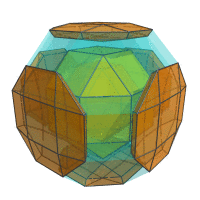
For clarity, we show only the rhombicuboctahedral cells, and render the other cells in a light transparent color. Brown cells lie on the far side of the polytope, whereas yellow cells lie on the near side. You can see the cells in the middle column rotating into and out of view as they rotate around the WZ plane. The four cells in the horizontal ring lie in the XY plane, which is the stationary plane of the WZ plane rotation. They are just barely on the limb of the projection, slightly bent to the far side due to the perspective projection used. In a parallel projection, they would lie exactly on the projection envelope.
The next animation shows the runcitruncated 16-cell in the same rotation, except that we show the truncated tetrahedral cells instead:
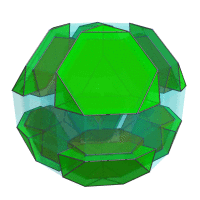
Green cells lie on the near side, and dark brown cells lie on the far side. As can be seen, these cells are rotating in 4 vertical circles, which themselves are rotating in the XY plane. As they do so, they trace out spiralling paths. These cells are also close to the limb of the polychoron, so you can see them flipping between the near side and the far side along their complex gyrating paths.
In these animations, the cells appear to be “passing through” each other and deforming in curious ways. However, this is merely an artifact of the projection from 4D into 3D. In their native 4D space, these cells do not touch each other, nor do they deform; the rotation is perfectly rigid.
Coordinates
The coordinates of the runcitruncated 16-cell are all permutations of coordinates and changes of sign of:
- (1, 1, (1+√2), (1+2√2))
These coordinates describe a runcitruncated 16-cell centered on the origin with edge length 2.




